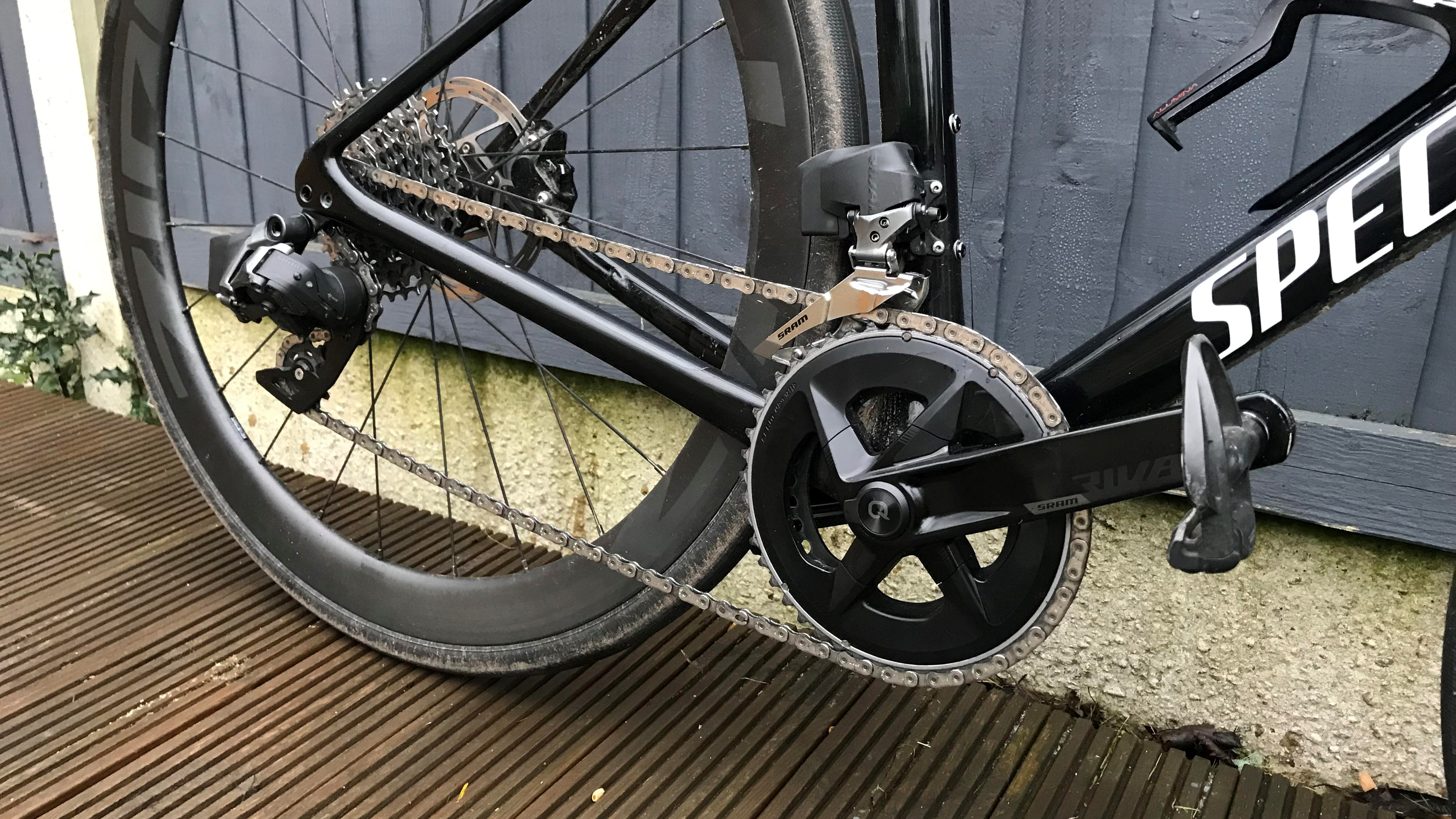Cyclingnews Verdict
Great wireless performance that shows electronic groupsets are steadily becoming cheaper, but while the performance is great, it's still tough to justify the cost
Pros
- +
Wireless shifting is smooth and reliable
- +
Wide range of gearing options
- +
Affordable power meter chainset
Cons
- -
Still an expensive groupset
- -
The shifter rubber hood fit is a little sloppy
- -
Not the lightest groupset
You can trust Cyclingnews
Sram Rival eTap AXS is the third-tier AXS groupset in the Sram range and was launched in the spring of 2021. The groupset is the most affordable AXS offering from Sram, aiming at providing an intuitive shift experience with simple, easy-to-use tech features. As a long-term Shimano user, I was certainly interested in spending some miles testing the groupset and seeing what it had to say for itself.
Rival is a 12-speed wireless groupset featuring hydraulic braking and is the more affordable, slightly less exotic younger sibling of the mid and upper-tier Force and Red eTap AXS groupsets above it. The Rival range is not solely pitched as being for road use, the groupsets are very much designed for gravel and adventure use as well. Sram has built on this with its XPLR range with AXS allowing you to mix and match from Force, Red and even the brand's mountain bike groupsets.
The groupset comes in at around £1,400 or $1,300 with the left-sided power meter chainset included and depending on which spec you need. As the groupset has been out for a while already, you can usually shop around and find deals online.
Now, this amount isn’t exactly peanuts, but as the best road bike groupsets embrace electronic shifting and the inclusion of an integrated power meter is almost expected, this is the way prices are going for what is technically a mid-tier groupset. A direct competitor and the obvious comparison to make in terms of the competition is with the slightly newer Shimano 105 R7100 groupset.
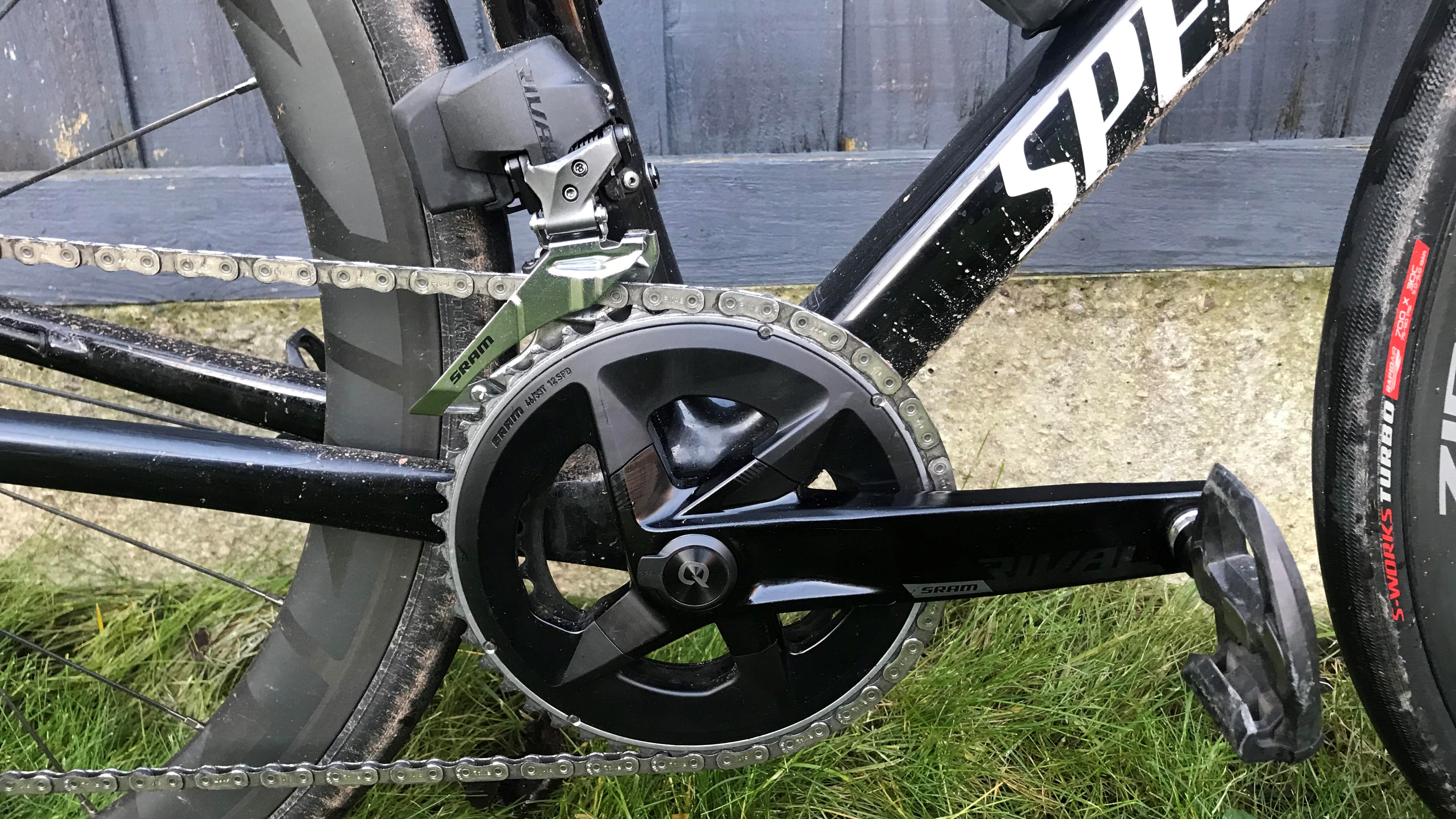
Design and specification
Rival AXS is easy on the eye, being constructed mainly from aluminium, steel and plastic, ditching the more expensive carbon fibre that can be found on the higher-spec groupsets. It's finished in mostly gloss black and dark grey with subtle Rival logos. The derailleurs are a little bigger overall than Shimano units, mainly due to the batteries mounting to the derailleurs. The shifters are a little bigger too.
The entire groupset comes in at just over 3kg, which means Rival is a little on the weighty side and around a couple of hundred grams heavier than the nearest Shimano 105 Di2 competition.
To keep costs down, there are a couple of features that Rival doesn't have compared to Force and Red. One is that it uses a spring clutch for chain retention in the rear derailleur instead of the Orbit fluid damper the two higher-tier groupsets use.
If you are unsure of the difference between the two systems, in Sram's words "the Orbit fluid damper consists of a silicone fluid damper with a one-way valve that controls the rear derailleur cage’s counter-clockwise rotation. This prevents the lower derailleur pulley from moving forward when bumps in the road cause g-force spikes that pull the chain downward". Put simply, a clutched derailleur works to keep the lower chainline taut, helping to prevent chain drops on rough terrain. The Rival spring clutch is a slightly less refined solution to the same issue, using a spring to keep the derailleur cage in position.
It might be less refined, but it still worked fine in my testing. I didn't experience any issues with this whilst riding on some rough roads. Neither system requires maintenance and both are sealed units so you won't have to worry about additional servicing costs there.
You also can't adjust the brake contact point of the Rival brake levers, just lever reach. Contact point refers to the point in the brake levers' stroke where the brake pads come into contact with the rotor. Some riders like the pads to hit the rotor very early on once they start pulling the lever, while others like some free movement before the brakes begin to bite. The exclusion of these features is by no means the end of the world though.
The groupset is electronic which of course means batteries, the front and rear derailleurs have their own batteries which mount directly to them and pair via Bluetooth to the shifters which use CR2032 batteries. The batteries themselves couldn't be easier to remove and install onto the derailleurs requiring no tools and are fully charged within an hour in the neat Sram charging dock. A full charge will last at least several weeks, and the system also goes into sleep mode when the bike is not in use to conserve battery. The coin-cell batteries in the shifters are equally easy to remove, and last months - if not years - in normal use before needing to be replaced.
The Sram AXS app also works in tandem with the groupset and by downloading it and pairing the groupset components, you can update firmware and customise shift buttons really easily. I did have to update the firmware on the power meter which was done in minutes. However, one thing I missed compared to Shimano's Di2 groupsets is the ability to adjust shift speed in the app.
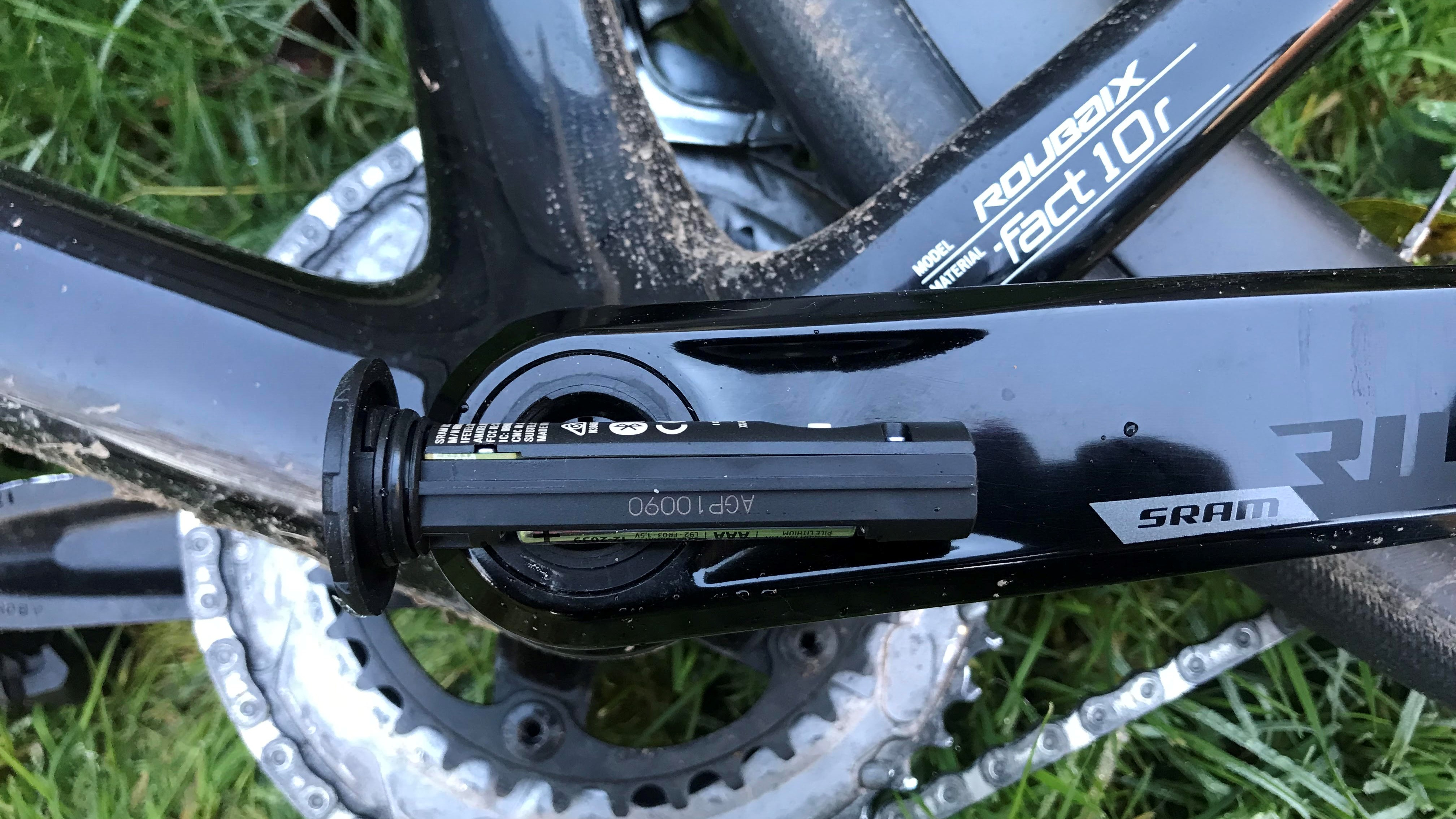
Another key point to go over is the Sram X-Range gearing and gear ratios. Sram claims there is no clear definition for 'road' these days and so provides a full range of alternate gearing options to suit varied riding types. Rival is available with single and double chainsets and those double chainring sizes can range from 43/30 in a 'wide spindle' for gravel bike chainline clearances, 46/33 and finally 48/35. For reference, the 1x options are 38T, 40T or 42T.
These chainset combinations are paired to Sram's 12-speed cassettes, in either 10-30 or 10-36 options, with 36 being largest the rear mech can deal with. The 10-tooth sprocket is the key to the wider gear range with a 48-10 combination giving a comparable gear to that of a regular semi-compact (52/36) chainset and 11-tooth sprocket. It's worth bearing in mind here that testing by Friction Facts has shown that a 10-tooth sprocket and smaller chainring sizes create slightly more chain manipulation and therefore slightly more drag. You can read a nice overview of this on the Kogel bearings website. This is something to consider if you racing and competing as you stand to lose a watt or two, but for most riders, it won't be noticable. There is also a useful gear comparison table on the Sram website which can help you compare gear ratio differences to help you choose the best configuration.
The Rival Quarq power meter is an option for the groupset and you can pick up the power meter chainset alone for around £239 or $291. This is as much as some left-hand crank-only power meters and represents really good value. The strain gauge is in the chainset axle and the battery slots into the end of the axle. I updated the firmware to fix a glitch and readings were accurate after this.
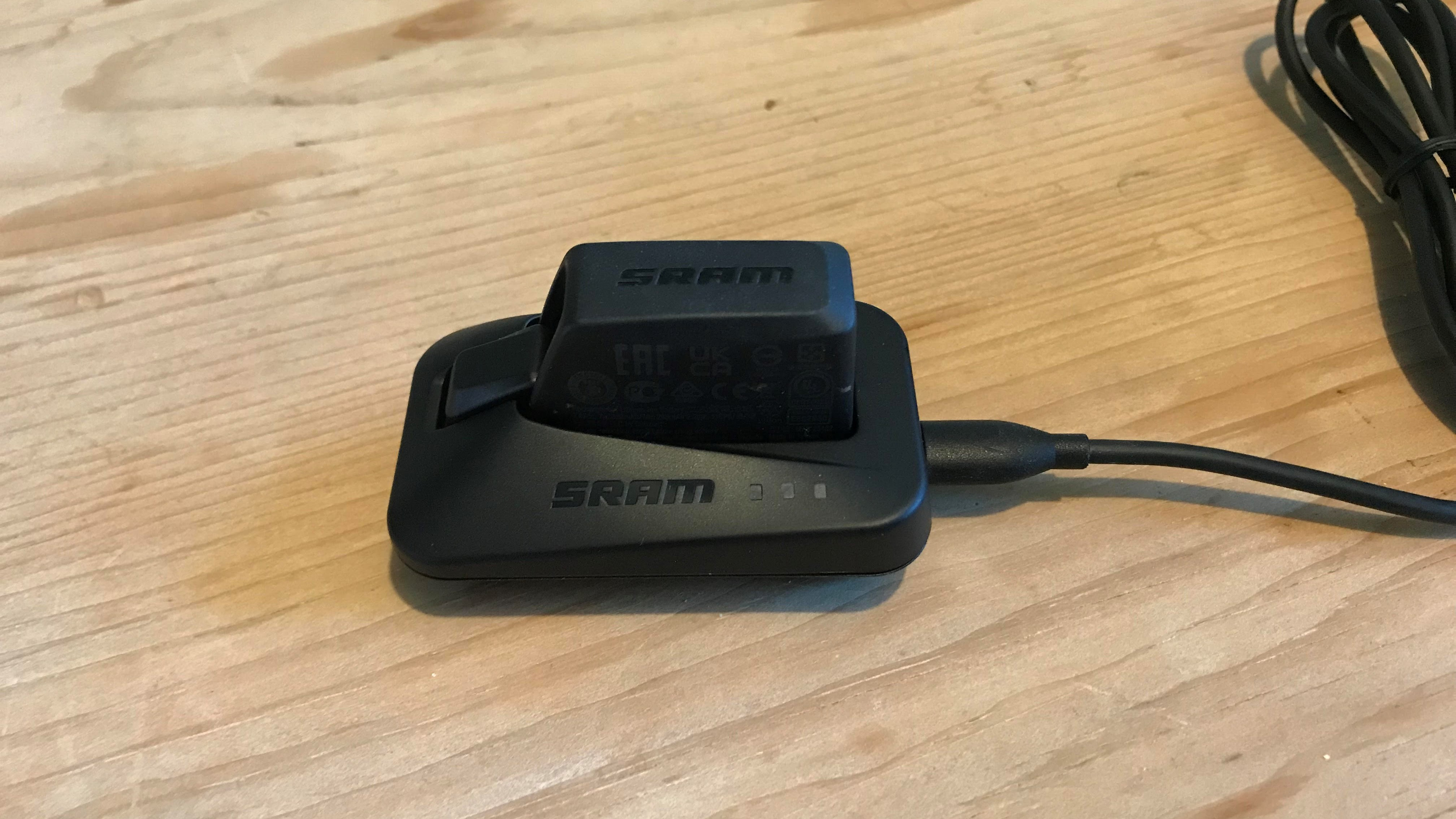
Braking is hydraulic and the Rival disc brake calipers use two pistons and dot brake fluid. Dot fluid isn't the most pleasant substance and it can have an adverse effect on components over time, so if you do partake in home servicing, be careful not to spill it onto other parts of the bike. Interestingly, Sram did release a mountain bike brake that uses mineral oil in spring this year so perhaps we will see more mineral oil brakes arriving in the future.
The Rival brakes also don't feature the Sram 'Bleeding Edge' bleed syringe fitting, which can save some time when bleeding the brakes. Of course, this is only relevant if you plan to maintain the brakes yourself, and I expect the majority of riders will use their local bike shop for this.
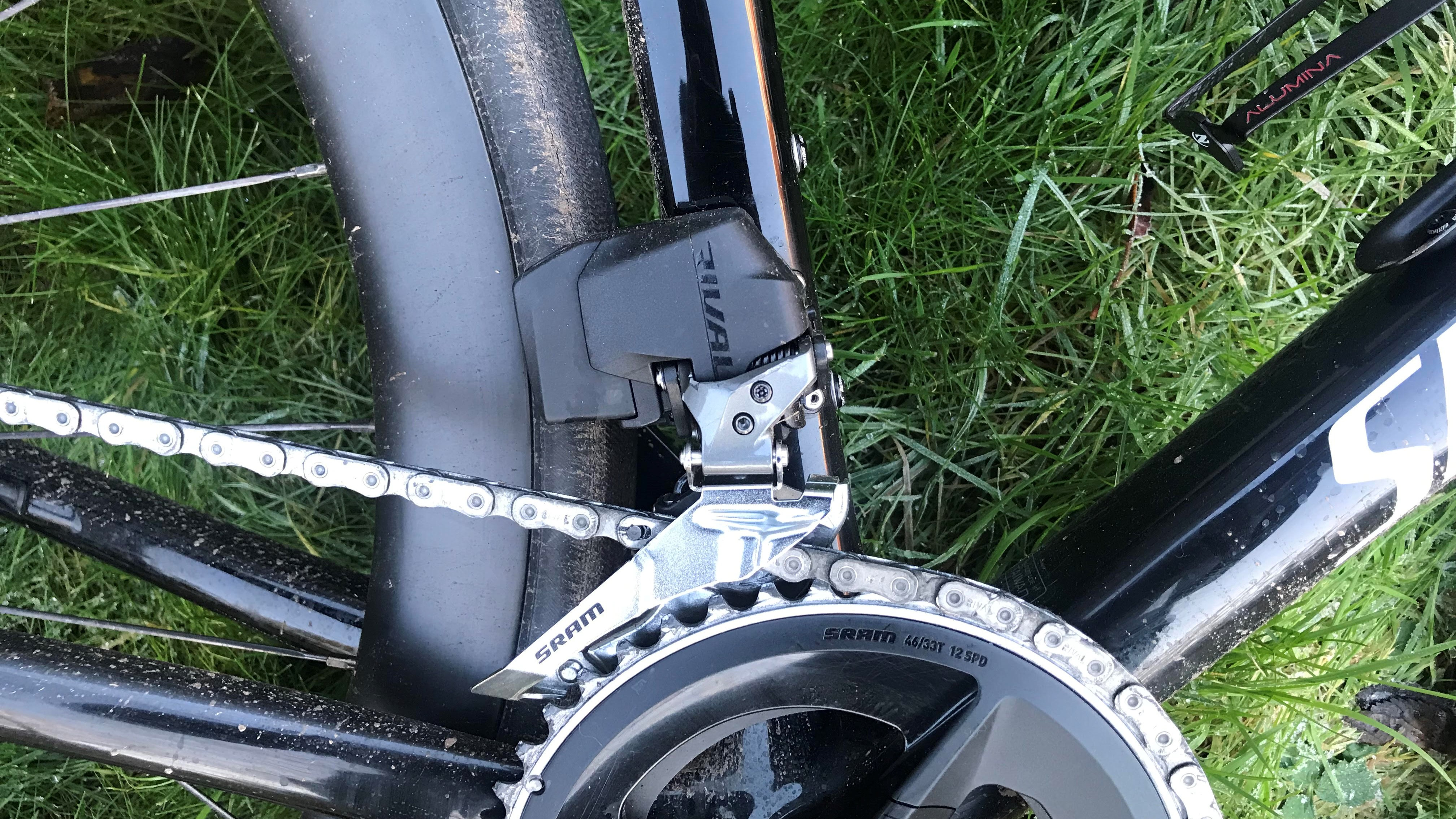
Performance
The groupset performed well on the road with my longest ride on it being around three hours. The shifting was smooth and it takes very little effort to change gears. I liked the textured rubber hoods and the grippy shifter paddles are a nice touch. A standout point of electronic shifting generally is the reduced shifter throw to change gears and this does save a little bit of effort over time or when hands are cold. Even if you aren't familiar with the term 'shifter throw' you will have experienced it yourself; this is simply the distance you have to push your shift lever to make a gear shift. It's significantly reduced on electronic groupsets, since instead of moving a cable through a ratchet, you're just pushing a button. You could argue the benefits of accumulated energy saving over longer rides, but ultimately, it's just a nice, precise, easy, tactile motion that is the same across all shifts.
The 46/33 chainset and 10-36T cassette on my test bike provided gearing that was easily low enough for the steepest climbs my local roads had to offer and I felt the lower gearing lent itself well to riding comfortably in zone two or at low intensity. I found myself comfortably spinning away a lot of the time working less hard than I perhaps normally would. I also found I was able to keep the chainline straighter in more situations, which I liked as it meant it was quieter. This also has the benefit of reducing drag from friction, and prolonging the life of the chain over time.
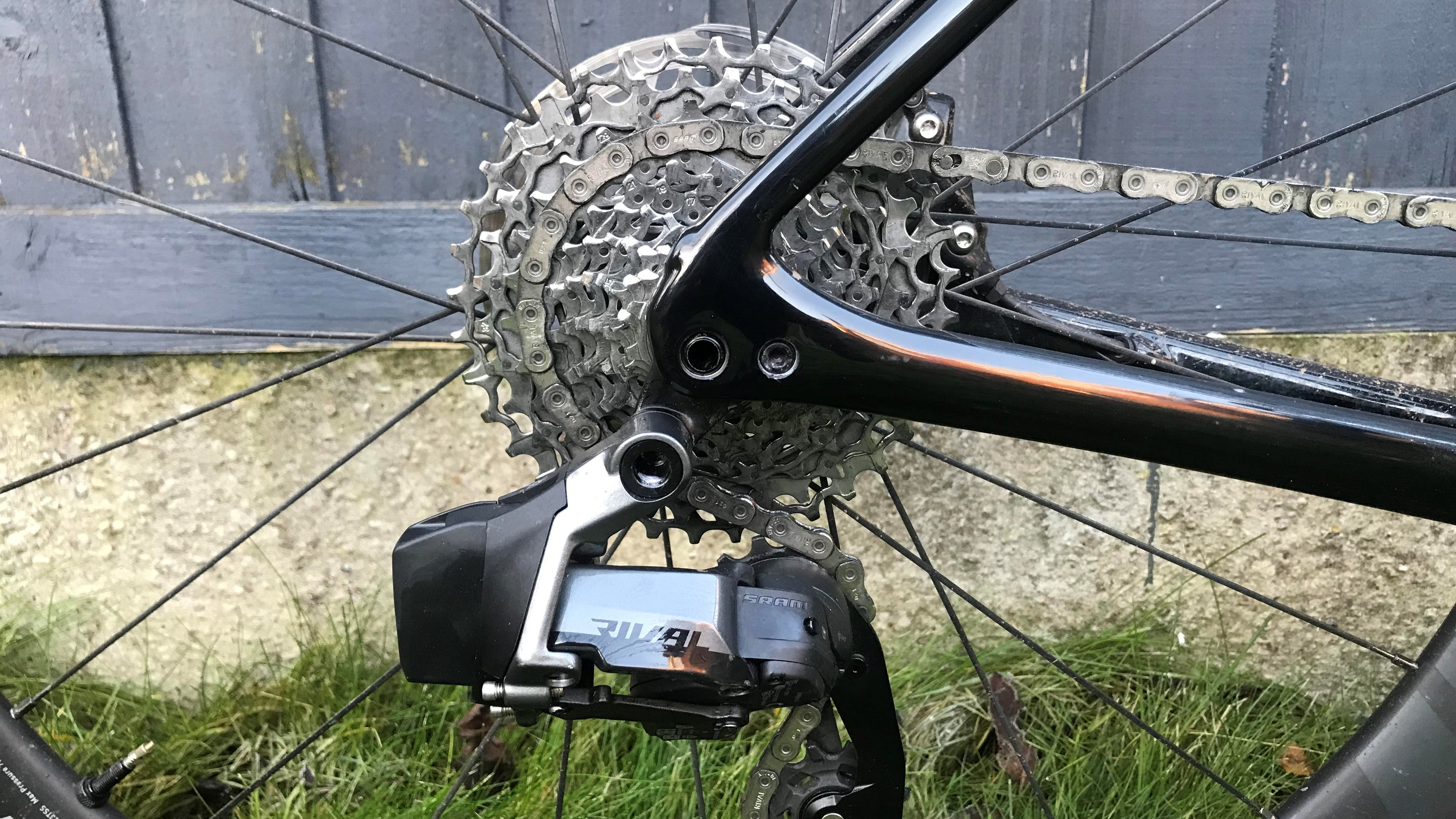
It is worth noting that electronic groupsets can still fall foul of some of the same niggles that can trouble mechanical groupsets from time to time. I did experience one over-shift that threw the chain off and over the outside of the big chainring briefly. It happened when I was rolling along on the flat and I corrected it with a downshift and a gentle pedal. However, given that it didn't occur again, and that even professional cyclists experience chain drops, I put it down to just bad luck for that one shift.
In my use, I found the Sram flat-top 12-speed chain to be really quiet, It has received criticism in some quarters for being overly noisy but I found it to be no louder than a Shimano or KMC offering. Gear shifts in and out of the saddle were always consistent, not lightning fast but pretty quick all the same. Downshifting deliberately from the big ring on a steep climb wouldn't drop the chain no matter how poorly I shifted under load.
As I've mentioned, shifting was fast and smooth but not mind-blowingly so. I feel electronic shifting can be placed on an otherworldly pedestal in terms of its performance at times. For instance, my own Shimano Ultegra R8000 mechanical groupset with Shimano Sil-Tec cables is easily as fast and slick.
I'm not trying to tee up a mechanical versus electronic debate here, both types of groupsets have their own pros and cons.
I do understand that not everyone is going to want to have to set up or maintain their own mechanical shifting, and the promise of a largely maintenance-free electronic groupset is an attractive proposition. I should also say that with the rise of integrated bar and stem combos with fully internal routing mean wireless electronic groupsets save both time and hassle when it comes to building a bike. I will also admit to liking the fact that you can hold a shift button and shift multiple sprockets up or down at once. This was really handy at times and is just a downright cool feature that only an electronic groupset can provide.
With all that said though, if an electronic groupset isn't an itch that you absolutely have to scratch, similar performance levels can be obtained from a well-set-up mechanical groupset, which can also be obtained for less money.
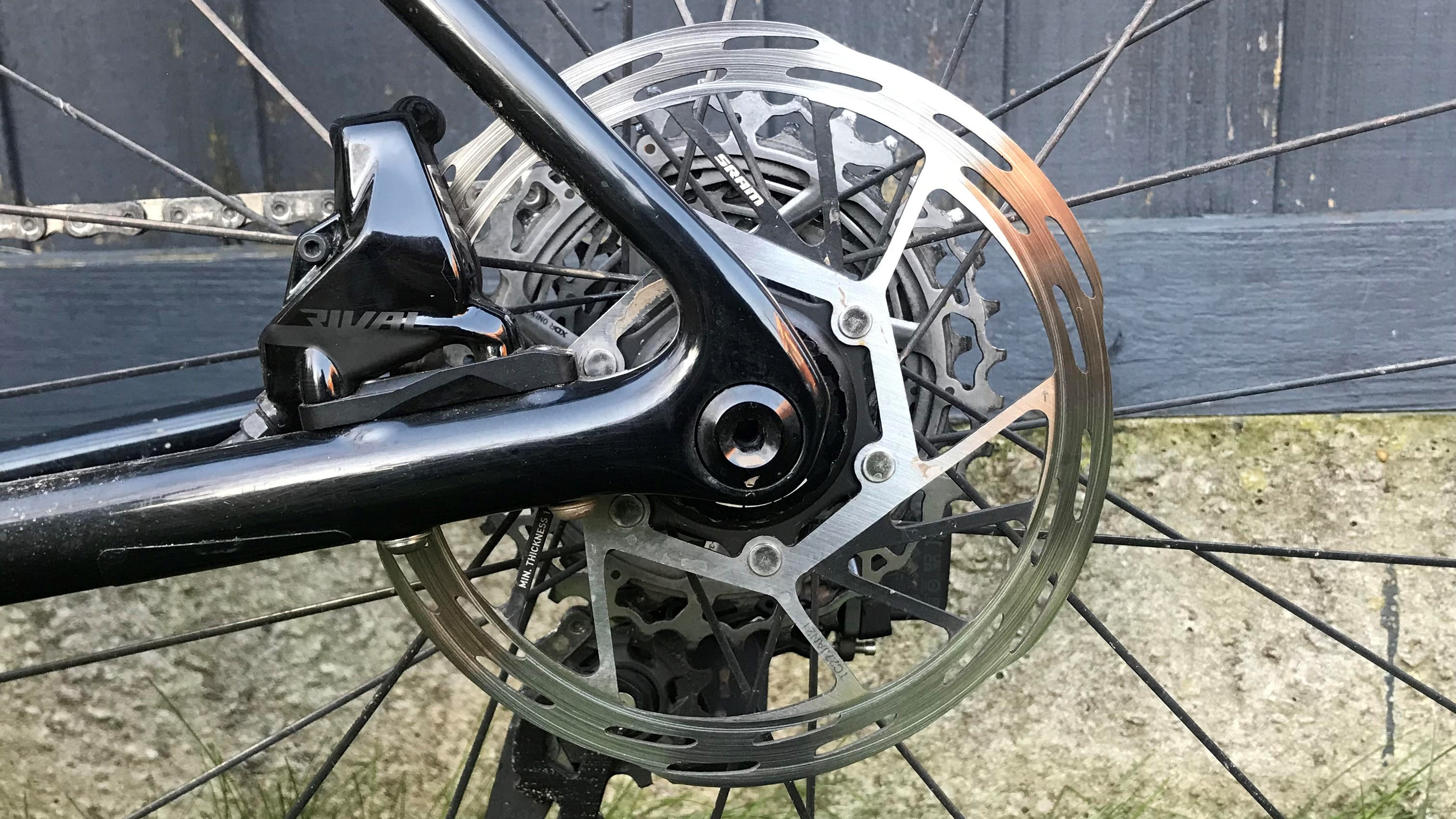
Something I didn't particularly like was the feel of the brake lever action. I found the brake lever feel to be a bit muted. The action when you pull the lever is smooth but it feels a little slow and draggy, a little like pulling the lever through treacle.
I would like it to feel a bit lighter and snappier. Braking power wasn't an issue and the stopping of the brakes was always consistent and smooth, the brake pistons themselves were clean and moving freely so I discounted this possibility.
Another point that niggled was the fit of the Sram rubber lever hoods, which had a bit of slop on either side of the lever creating a one-two millimetre gap around the shifter. Holding the shifters, I could constantly feel this loose rubber.
The groupset was pre-fitted to a test bike so this may have just been an issue that's developed through use over time, but it's still something to look out for. I also noted a similar issue on Force levers when riding the YT Szepter a couple of months ago. It's worth saying this isn't a problem exclusive to Sram, though, as the Cyclingnews team have experienced this with all three of the big groupset brands.
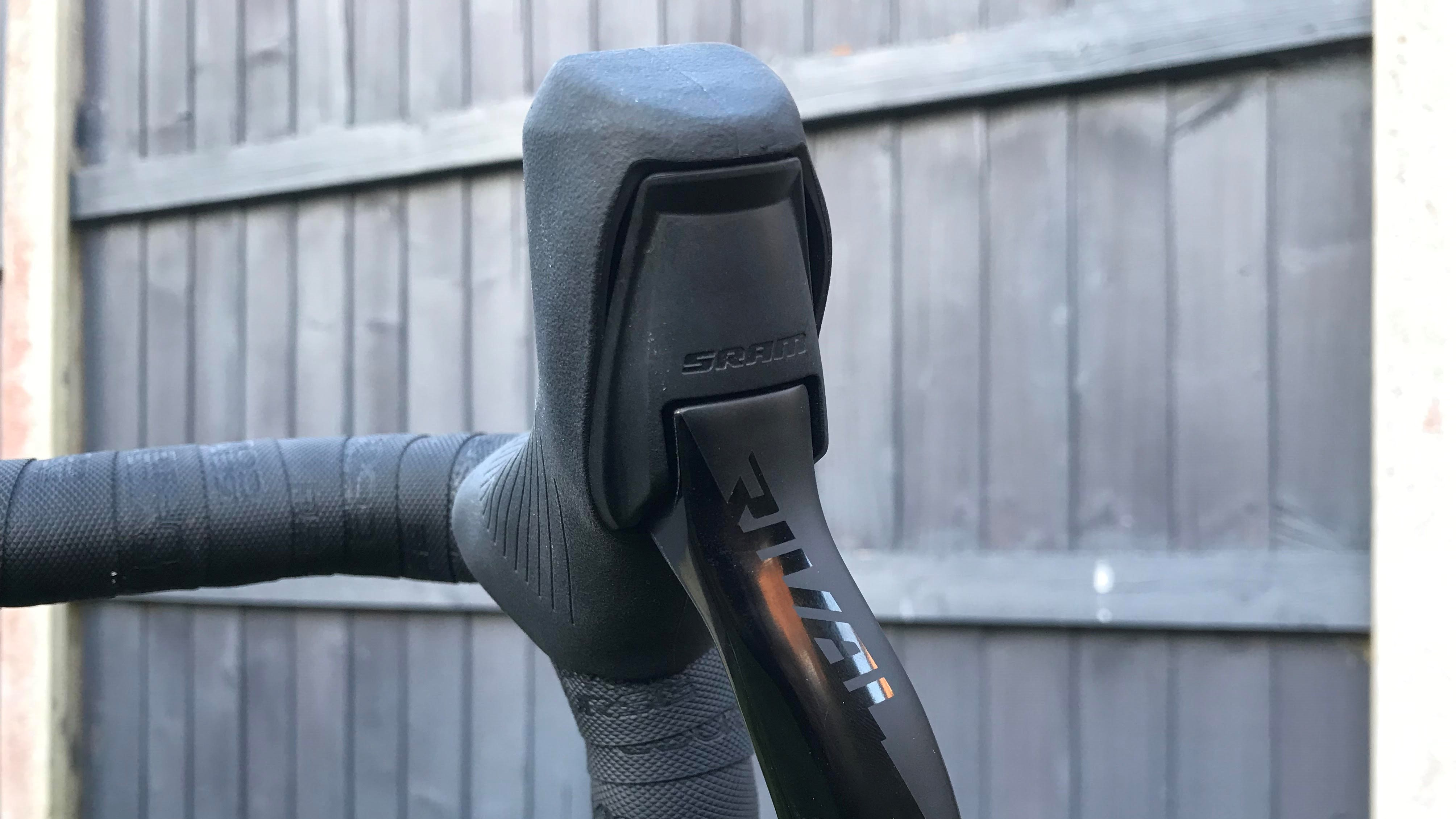
Verdict
I enjoyed riding with and using the Rival AXS groupset, shifting is smooth and effortless and despite the loose rubber, the shifters are comfortable to hold in various hand positions. There is a range of gearing options available that would be particularly useful for long or hilly events not to mention gravel use. My preferred gearing for the road is 52/36 and 12-28 at the rear, so I would probably opt for the 48/35 tooth chainset version for myself if I was going to ride it full time.
Braking was also excellent, not once did I have to deal with rotor rub or squealing of any kind and I did ride in wet conditions. Aside from the dull lever feel, braking was powerful and consistent across the board.
However, to judge just the ride performance alone, I think getting on for £1,400 / $1,300 (spec-depending) is still a lot of money to spend, given that similar levels of shifting performance can be achieved from more affordable mechanical groupsets with quality cables.
If however, you do want to upgrade to electronic wireless shifting, the Rival eTap is the Sram entry point, and along with Shimano 105 Di2, is the most affordable of the electronic groupsets out there at the moment. Electronic shifting is becoming steadily more affordable, and an electronic groupset does bring some of its own advantages such as easy setup, low maintenance and adjustability via an app. If you want an integrated power meter, don't want to worry about mechanical maintenance, and want the low hassle and push-of-a-button shifting that an electronic groupset brings, Rival is genuinely a great option.
Whether it's worth the investment, I think that comes down to how much you value the convenience and electronic wow factor. I liked the Rival AXS groupset, but would personally save my money and stick with cables.
| Value | £1400 / $1300 is still pretty expensive for an off the shelf mid tier - albeit electronic - groupset, but you can't deny that it's currently the cheapest in its class | 7/10 |
| Weight | The groupset comes in at around 3kg making it no featherweight | 5/10 |
| Gearing options | A wide range to suit nearly every requirement | 9/10 |
| Ergonomics | The shifters are comfortable and grippy, let down only by loose rubber | 8/10 |
| Shifting quality | Smooth, quiet and consistent | 9/10 |
| Overall | Row 5 - Cell 1 | 76% |

Tom joined the Cyclingnews team in late 2022 as a tech writer. Despite having a degree in English Literature he has spent his entire working life in the cycling industry in one form or another. He has over 10 years of experience as a qualified mechanic, with the last five years before joining Cyclingnews being spent running an independent workshop. This means he is just as happy tinkering away in the garage as he is out on the road bike, and he isn’t afraid to pull a bike apart or get hands-on with it when testing to really see what it’s made of.
He has ridden and raced bikes from an early age up to a national level on the road and track, and has ridden and competed in most disciplines. He has a keen eye for pro-team tech and enjoys spotting new or interesting components in the wild. During his time at Cyclingnews, Tom has already interviewed some of the sport's biggest names including Mathieu van der Poel, Tadej Pogačar and Alberto Contador. He's also covered various launches from brands such as Pinarello, Ridley, Specialized and more, tackled the Roubaix Challenge sportive aboard his own rim-brake Cannondale SuperSix Evo, tested over 20 aero helmets in the wind tunnel, and has created helpful in-depth buying advice relating to countless categories from torque wrenches to winter clothing.
